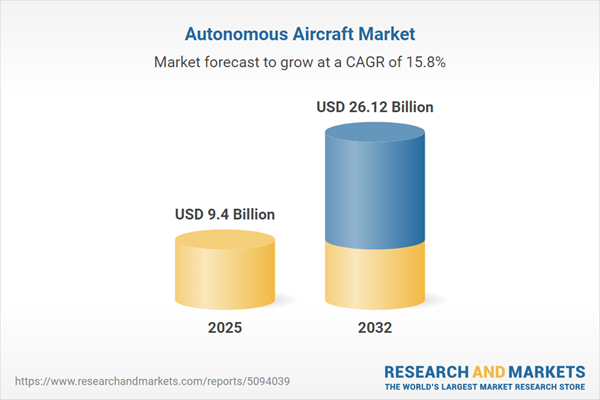Speak directly to the analyst to clarify any post sales queries you may have.
Rapid advancements in autonomous aircraft technology are compelling aviation leaders to refine strategy, modernize operations, and address emerging risks in fast-evolving commercial and defense settings.
Market Snapshot: Autonomous Aircraft Market Size and Growth
The autonomous aircraft market reached USD 8.09 billion in 2024, is set to grow to USD 9.40 billion in 2025, and is projected to attain USD 26.12 billion by 2032, reflecting a compound annual growth rate (CAGR) of 15.77%. Sector growth is primarily driven by robust investment in advanced digital aviation systems and pioneering innovation in next-generation avionics. Closer collaboration between commercial and defense stakeholders is accelerating the deployment of intelligent solutions across various segments. Propulsion and sensor technology improvements are broadening the use of autonomous aircraft in sectors ranging from logistics and infrastructure monitoring to agricultural support and safety-critical emergency response. Organizations demonstrating agility in navigating regulatory change and adapting to supply chain volatility are well-positioned to capture enduring market advantage.
Scope & Segmentation: Strategic Insights for Aviation Leaders
This authoritative report delivers precise segmentation and clear analysis to inform senior-level decisions along intricate aviation value chains:
- Application Areas: Emergency response, agriculture, package delivery, mapping, inspection, operational monitoring, and surveying—all contributing to efficiency, safety, and transparency in diverse aviation scenarios.
- Platform Types: Fixed wing, rotary wing, multirotor, hybrid wing, and tilt rotor solutions, providing executives with options tailored to mission-specific requirements from long-range endurance to agile vertical takeoff and landing.
- Propulsion Technologies: Electric (battery and fuel cell-powered), hybrid, and conventional propulsion systems, each addressing sustainability goals and supporting operational reliability within regulatory constraints.
- Core Components: Avionics, communication equipment, navigation technology, propulsion subsystems, and integrated payloads forming the backbone for automated, coordinated, and resilient flight operations.
- End Users: Commercial organizations, military agencies, and recreational operators, each requiring scalable and lifecycle-optimized solutions that adapt to changing mission demands.
- Operational Altitudes: High, medium, and low-altitude operation enables compliance with distinct regional and airspace mandates, supporting adaptation to localized infrastructure or regulatory challenges.
- Geographic Coverage: Americas, Europe, Asia-Pacific, Middle East, and Africa—influenced by infrastructure maturity and regulatory frameworks shaping adoption rates and scalability of technology rollout.
- Key Industry Participants: Leading entities include Da-Jiang Innovations Science and Technology, General Atomics Aeronautical Systems, Northrop Grumman, Boeing, Lockheed Martin, Airbus, Textron, Leonardo, Elbit Systems, and AeroVironment, who set the pace for sector-wide innovation and collaboration.
Key Takeaways for Senior Decision-Makers
- Engagement with aviation authorities at the earliest stages streamlines certification and expedites access to both domestic and international markets while reducing compliance risk.
- Integrating digital twin and machine learning solutions optimizes predictive maintenance, resulting in better asset management and greater operational assurance.
- Diversification of supplier relationships and the cultivation of strategic partnerships build resilience, especially regarding electronics and energy storage reliability.
- Implementation of proactive cybersecurity measures, including continuous threat monitoring and strong data encryption, is essential to protecting assets and maintaining business continuity throughout stakeholder networks.
- Agile business models that anticipate and react to regulatory developments enhance adaptability and support success in diverse market environments.
Tariff Impact: Navigating Evolving Trade Policies
Recent tariff increases on U.S. aerospace components have introduced additional complexity and heightened costs for global manufacturing networks. Aviation stakeholders are addressing these pressures by advancing localized and nearshore sourcing, establishing more diversified supplier networks, and optimizing inventory strategies. These practical measures are key for ensuring supply chain continuity and limiting the risk of disruption amid ongoing global trade shifts.
Methodology & Data Sources
This market study on autonomous aircraft is grounded in industry leader interviews, enriched by detailed secondary research and regulatory filings. Rigorous cross-referencing of all findings guarantees that the analysis is closely aligned with the executive perspective and delivers actionable outcomes.
Why This Report Matters
- Supports senior aviation executives in optimizing supply chain strategies and directing resources toward impactful technology investments.
- Supplies succinct perspectives on shifting global regulatory and policy trends, enabling organizations to remain agile in changing conditions.
- Equips leaders with the analytical insights necessary for sound strategic planning in an environment shaped by rapid technology evolution and emerging geopolitical considerations.
Conclusion
By harnessing thorough market intelligence, executive teams can refine operational tactics, respond effectively to sector changes, and secure long-term growth in the autonomous aircraft market landscape.
Additional Product Information:
- Purchase of this report includes 1 year online access with quarterly updates.
- This report can be updated on request. Please contact our Customer Experience team using the Ask a Question widget on our website.
Table of Contents
3. Executive Summary
4. Market Overview
7. Cumulative Impact of Artificial Intelligence 2025
Companies Mentioned
The companies profiled in this Autonomous Aircraft market report include:- Da-Jiang Innovations Science and Technology Co., Ltd.
- General Atomics Aeronautical Systems, Inc.
- Northrop Grumman Systems Corporation
- The Boeing Company
- Lockheed Martin Corporation
- Airbus S.A.S.
- Textron Inc.
- Leonardo S.p.A.
- Elbit Systems Ltd.
- AeroVironment, Inc.
Table Information
| Report Attribute | Details |
|---|---|
| No. of Pages | 186 |
| Published | November 2025 |
| Forecast Period | 2025 - 2032 |
| Estimated Market Value ( USD | $ 9.4 Billion |
| Forecasted Market Value ( USD | $ 26.12 Billion |
| Compound Annual Growth Rate | 15.7% |
| Regions Covered | Global |
| No. of Companies Mentioned | 11 |









